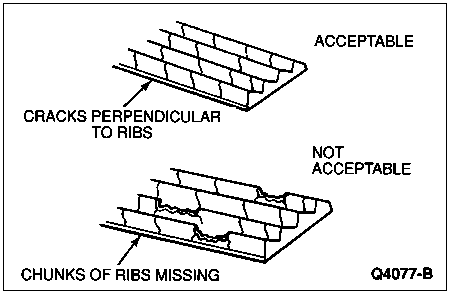
Section 03-05: Drive Belts, Accessory | 1996 F-Series, Bronco Workshop Manual |
Drive Belt Cracking/Chunking/Wear
Under severe operating conditions (high temperatures, low humidity), drive belt rib cracking can occur at less than 96,000 km (60,000 miles). Drive belt rib cracking perpendicular to the belt ribs is not a reason for concern and has no detrimental effect on belt performance. Cracks parallel to ribs are not acceptable.
Drive belt chunking means that the rubber material actually chunks out between the cracks. The drive belt (8620) should be replaced if chunking occurs.

Drive Belt Noise/Flutter
Drive belt chirp is a regularly occurring chirping noise that occurs due to pulley misalignment or excessive pulley runout. It can be a result of a damaged pulley or an improperly replaced pulley that was not properly aligned.
To correct, determine the area where the noise comes from. Then check each of the pulleys in that area with a straightedge to the crankshaft pulley (6312) and look for the accessory pulleys to be out of position in the fore/aft direction or at an angle to the straightedge.
Belt squeal is an intermittent noise that occurs when the drive belt slips on a pulley during certain conditions such as: engine start-up, rapid engine acceleration, or A/C clutch engagement.
Drive belt squeal can occur under the following conditions:
If the A/C discharge pressure goes above 2895 kPa (420 psi). This can occur if:
If A/C OFF equalized pressure (the common discharge and suction pressure that occurs after several minutes) exceeds 965 kPa (140 psi), which is a rare occurrence at high ambient temperatures with a hot engine, turn A/C off for a few seconds and then back on after fan blade begins to cool A/C condenser core.
If any of the accessories are damaged, or have a worn or damaged bearing or internal torsional resistance above normal for any reason. All of the accessories should be rotatable by hand in the unloaded condition. If any are not, the accessories should be inspected.
If fluid gets on the drive belt. Fluids include power steering fluid, engine coolant, engine oil or air conditioning system lubricant.
If fluid does get on the drive belt during service, the best policy is to clean the drive belt with soap and water and thoroughly rinse with clean water. The drive belt does not have to be replaced if no apparent damage has occurred.
If drive belt is too long. A drive belt that is too long will allow the drive belt tensioner arm to go all the way to drive belt tensioner arm travel stop under certain load conditions, which will untension the drive belt. If the drive belt tensioner (6B209) is resting on the stop, replace the drive belt.
If the drive belt tensioner is worn or damaged. The drive belt tensioner arm should rotate freely without binding.